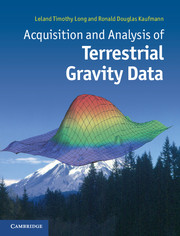Book contents
- Frontmatter
- Contents
- Preface
- 1 Gravitational attraction
- 2 Instruments and data reduction
- 3 Field acquisition of gravity data
- 4 Graphical representation of the anomalous field
- 5 Manipulation of the gravity field
- 6 Interpretation of density structure
- 7 The inversion of gravity data
- 8 Experimental isostasy
- A Appendix ACommon definitions and equations in potential theory
- B Appendix BGlossary of symbols
- References
- Index
5 - Manipulation of the gravity field
Published online by Cambridge University Press: 05 February 2013
- Frontmatter
- Contents
- Preface
- 1 Gravitational attraction
- 2 Instruments and data reduction
- 3 Field acquisition of gravity data
- 4 Graphical representation of the anomalous field
- 5 Manipulation of the gravity field
- 6 Interpretation of density structure
- 7 The inversion of gravity data
- 8 Experimental isostasy
- A Appendix ACommon definitions and equations in potential theory
- B Appendix BGlossary of symbols
- References
- Index
Summary
Objective of gravity field manipulation
The gravity field may be displayed as discrete points corresponding to points of observation, as an extrapolation of these points to a regularly spaced grid, and as an interpretation in the form of a contour map. Each representation has intrinsic advantages and deficiencies. Although the distribution of observations in the field is rarely in a form that is convenient for an efficient application of computer-based analysis techniques, discrete point locations offer the most precise and honest representation of the data. Also, discrete point locations minimize the introduction of artifacts often associated with extrapolations in graphical presentations of gravity data. The extrapolation of gravity values to a regularly spaced grid simplifies the application of computer programs for analysis; but, the precision of the interpolated value at individual grid point locations can vary widely over the map area. The precision will be low, for example, in areas where the data density is low and where the data distribution is poorly suited for the chosen extrapolation technique. The precision will be high in areas where multiple observations define the value at the grid point location. A contoured presentation displays the data in a form that is easy to visualize. However, a contoured presentation always adds some element of interpretation to the field observations. Contouring programs require assumptions concerning the smoothness of the field in order to extrapolate values to areas without field observations. If the contouring technique, for example, fits a plane to the closest points, then small errors in a tight cluster of data could result in a steep slope to the plane. Extrapolating this plane to adjacent areas without supporting data could lead to large deviations from the actual field value, a common problem with some older contouring programs. Also, contouring programs rely on spatial gridding algorithms such as minimum curvature and kriging, each with their own benefits and limitations of how accurately they honor the data and how they interpolate values. The manual contouring of many older maps by skilled draftsmen often provides a more pleasing and realistic representation of the gravity field.
- Type
- Chapter
- Information
- Acquisition and Analysis of Terrestrial Gravity Data , pp. 69 - 98Publisher: Cambridge University PressPrint publication year: 2013



